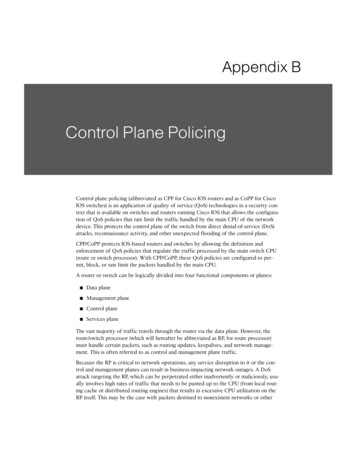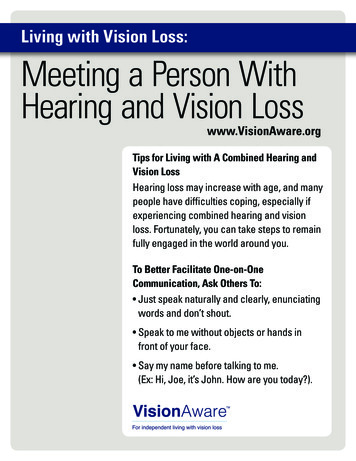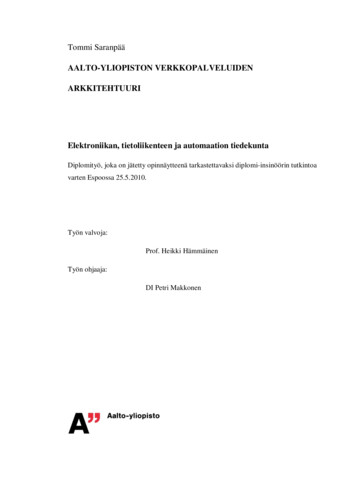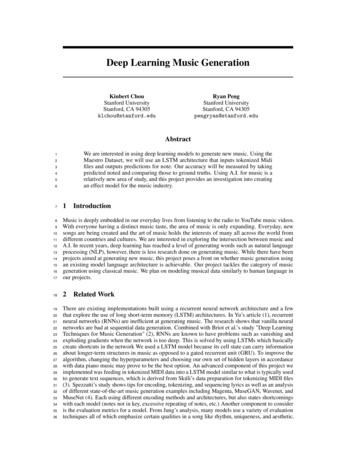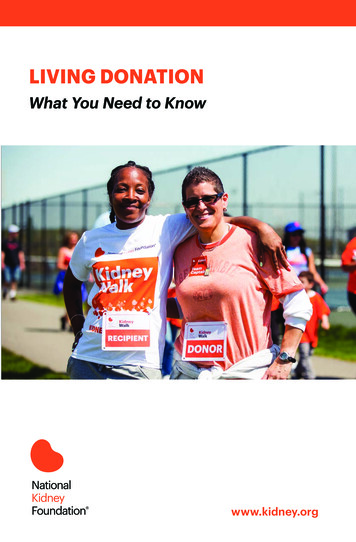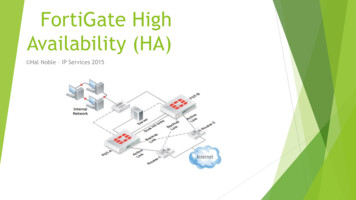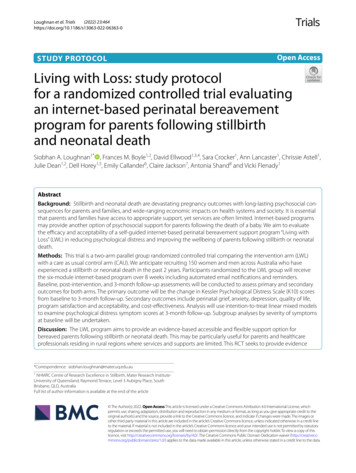
Transcription
(2022) 23:464Loughnan et al. en AccessSTUDY PROTOCOLLiving with Loss: study protocolfor a randomized controlled trial evaluatingan internet‑based perinatal bereavementprogram for parents following stillbirthand neonatal deathSiobhan A. Loughnan1* , Frances M. Boyle1,2, David Ellwood1,3,4, Sara Crocker1, Ann Lancaster1, Chrissie Astell1,Julie Dean1,2, Dell Horey1,5, Emily Callander6, Claire Jackson7, Antonia Shand8 and Vicki Flenady1AbstractBackground: Stillbirth and neonatal death are devastating pregnancy outcomes with long-lasting psychosocial consequences for parents and families, and wide-ranging economic impacts on health systems and society. It is essentialthat parents and families have access to appropriate support, yet services are often limited. Internet-based programsmay provide another option of psychosocial support for parents following the death of a baby. We aim to evaluatethe efficacy and acceptability of a self-guided internet-based perinatal bereavement support program “Living withLoss” (LWL) in reducing psychological distress and improving the wellbeing of parents following stillbirth or neonataldeath.Methods: This trial is a two-arm parallel group randomized controlled trial comparing the intervention arm (LWL)with a care as usual control arm (CAU). We anticipate recruiting 150 women and men across Australia who haveexperienced a stillbirth or neonatal death in the past 2 years. Participants randomized to the LWL group will receivethe six-module internet-based program over 8 weeks including automated email notifications and reminders.Baseline, post-intervention, and 3-month follow-up assessments will be conducted to assess primary and secondaryoutcomes for both arms. The primary outcome will be the change in Kessler Psychological Distress Scale (K10) scoresfrom baseline to 3-month follow-up. Secondary outcomes include perinatal grief, anxiety, depression, quality of life,program satisfaction and acceptability, and cost-effectiveness. Analysis will use intention-to-treat linear mixed modelsto examine psychological distress symptom scores at 3-month follow-up. Subgroup analyses by severity of symptomsat baseline will be undertaken.Discussion: The LWL program aims to provide an evidence-based accessible and flexible support option forbereaved parents following stillbirth or neonatal death. This may be particularly useful for parents and healthcareprofessionals residing in rural regions where services and supports are limited. This RCT seeks to provide evidence*Correspondence: siobhan.loughnan@mater.uq.edu.au1NHMRC Centre of Research Excellence in Stillbirth, Mater Research InstituteUniversity of Queensland, Raymond Terrace, Level 3 Aubigny Place, SouthBrisbane, QLD, AustraliaFull list of author information is available at the end of the article The Author(s) 2022. Open Access This article is licensed under a Creative Commons Attribution 4.0 International License, whichpermits use, sharing, adaptation, distribution and reproduction in any medium or format, as long as you give appropriate credit to theoriginal author(s) and the source, provide a link to the Creative Commons licence, and indicate if changes were made. The images orother third party material in this article are included in the article’s Creative Commons licence, unless indicated otherwise in a credit lineto the material. If material is not included in the article’s Creative Commons licence and your intended use is not permitted by statutoryregulation or exceeds the permitted use, you will need to obtain permission directly from the copyright holder. To view a copy of thislicence, visit http:// creat iveco mmons. org/ licen ses/ by/4. 0/. The Creative Commons Public Domain Dedication waiver (http:// creat iveco mmons. org/ publi cdoma in/ zero/1. 0/) applies to the data made available in this article, unless otherwise stated in a credit line to the data.
Loughnan et al. Trials(2022) 23:464Page 2 of 15of the efficacy, acceptability, and cost-effectiveness of the LWL program and contribute to our understanding of therole digital services may play in addressing the gap in the availability of specific bereavement support resources forparents following the death of a baby, particularly for men.Trial registration: Australian New Zealand Clinical Trials Registry, ACTRN 12621 00063 1808. Registered prospectivelyon 27 May 2021.Keywords: Stillbirth, Neonatal death, Pregnancy loss, Perinatal, Internet, Online, Bereavement, Grief, Distress, AnxietyAdministrative informationTitleLiving with Loss: Study protocol for a randomisedcontrolled trial evaluating an internet-based perinatal bereavement program for parents followingstillbirth and neonatal deathTrial registrationAustralian New Zealand Clinical Trials Registry(ANZCTR), ACTRN12621000631808, registered prospectively on 27/05/2021 https:// www. anzctr. org. au/ Trial/ Regis trati on/ Trial Review. aspx? id 38123 1& isRev iew true. ANZCTR collects and publiclydisplays the WHO Trial Registration Data Set.Protocol version14th March 2022; version 1.1FundingThe Living with Loss project is supported by theAustralian Government’s Medical Research FutureFund (MRFF) Rapid Applied Research Translationprogram grant awarded to Health TranslationQueensland (formerly Brisbane Diamantina HealthPartners; BDHP).Author affiliations1NHMRC Centre of Research Excellence in Stillbirth,Mater Research Institute-University of Queensland,Raymond Terrace, Level 3 Aubigny Place, SouthBrisbane QLD AUSTRALIA2Institute for Social Science Research, The University of Queensland, 80 Meiers Rd, IndooroopillyQLD AUSTRALIA3School of Medicine, Griffith University, ParklandsDrive;4Gold Coast University Hospital, 1 Hospital Drive,Southport QLD AUSTRALIA5La Trobe University, Plenty Rd &, Kingsbury Dr,Bundoora VIC AUSTRALIA6Monash University, 553 St Kilda Road, MelbourneVIC AUSTRALIA7The University of Queensland, St Lucia QLDAUSTRALIA8Faculty of Medicine and Health, The University ofSydney, Camperdown NSW AUSTRALIAName and contactinformation for thetrial sponsorRole of sponsorFunding is administered by The University ofQueensland for Health Translation Queensland(formerly Brisbane Diamantina Health Partners) andsub-contracted to the Centre of Research Excellence in Stillbirth (Stillbirth CRE), Mater ResearchInstitute-University of Queensland. Research officelocated at: Cumbrae Stewart building 72, St Luciacampus, Brisbane Queensland Australia; Phone: 61 7 3365 3560The sponsor has no role in the design of this studyand will not have any role during its execution,analyses, interpretation of data, or decision tosubmit results.Composition, rolesand responsibilitiesCoordinating centre and data managementteam: The Centre of Research Excellence inStillbirth (Stillbirth CRE), Mater Research InstituteUniversity of Queensland based in BrisbaneQueensland Australia is responsible for theoverarching conduct and coordination of thisstudy. The coordinating research team (SL, SC, AL,CA, FB, DE, VF) are based at the Stillbirth CRE andare responsible for the day-to-day conduct of thestudy including participant monitoring and datamanagement.Steering committee: An advisory group hasbeen established to oversee and review conductof this study with meetings scheduled everythree months, and monthly updates providedvia email correspondence. This steering groupincludes bereaved parents, health care professionals, clinicians, researchers, and parent supportand advocacy organisations. The role of this groupis to provide specialist knowledge of perinatalbereavement care and mental health, lived experience of perinatal loss, and trial support and advicethroughout all stages of the study, including development, evaluation, and dissemination of findings.BackgroundThe death of a baby during pregnancy or soon afterbirth is a devastating outcome for families and remainsa public health priority in Australia and internationally.In Australia, eight stillbirths (defined as the birth of ababy without signs of life after 20 weeks gestation) andneonatal deaths (defined as a baby that dies after birthwithin 28 days) occur each day, with little change in ratesover the past 30 years [1–4]. The long-lasting psychological and emotional consequences for parents, families, and care providers, and the wide-ranging impactson health systems and society are now well-recognized[5, 6]. Bereaved parents report intense sadness, anxiety,guilt, anger, and experiences of stigma, shame, and disenfranchisement of their grief [7, 8]. Perinatal bereavement is also associated with increased risk for persistentpsychological difficulties including posttraumatic stressdisorder (PTSD), major depressive disorder (MDD), andprolonged grief disorder (PGD) [6, 9].The provision of respectful and supportive perinatal bereavement care to parents and families aroundstillbirth and neonatal death is a major contributor to their immediate and long-term wellbeing [10].
Loughnan et al. Trials(2022) 23:464Community-based settings are vital to providing ongoing support to parents following hospital discharge, butsupport received is often inadequate [4, 11, 12]. TheLancet Ending Preventable Stillbirth Series highlightedthe unmet needs of bereaved parents following hospital discharge with 31% of women describing their posthospital care after stillbirth as poor [4, 11]. Critical gapsexist in the transition from hospital-to-home and in providing ongoing bereavement support for families following a baby’s death [4, 11, 12]. Health professionals reportbarriers to the effective provision of perinatal bereavement care, including insufficient training and experiencein bereavement care, a lack of clear care pathways, andlimited availability of support systems and structures forparents [5].Access to a range of bereavement support options isoften recommended to meet the varying needs of individuals [13]. Yet little is known about the acceptability and effectiveness of different types of bereavementsupport, and whether this differs between parents [14].For men, in particular, the psychological and emotional impact of stillbirth and neonatal death has beenunder-explored in comparison to women [15–17]. Asystematic review by Obst and colleagues highlightedthe importance of tailored perinatal bereavement support resources that validated men’s experiences of grieffollowing a baby’s death [18].Over the past two decades, the digital delivery of mental health services via the Internet has been increasinglyused in Australia to reduce barriers to care provision andincrease availability and accessibility of services. Internetbased interventions, predominately based on cognitivebehavioral therapy (referred to as “iCBT”), are now wellestablished for the treatment of a range of mental healthdisorders including anxiety and depression in childrenand adolescent [19], and general adult [20], and perinatal populations [21–23]. Digital mental health tools andservices already form part of routine care in many countries, often operating within a stepped-care approach asa stand-alone service (i.e., low-intensity support) or inconjunction with face-to-face care services (i.e., highintensity support) [24, 25]. Low-intensity internet-basedprograms, with or without therapist guidance or coaching, can provide users with a self-managed flexible support option that can be accessible at any convenienttime or place (e.g., at home) and can allow for a greaterdegree of anonymity and privacy [20, 25]. This is possiblyimportant in the context of perinatal bereavement giventhe death of a baby during pregnancy often receives little community acknowledgement. Many parents may bereluctant to seek help and disclose emotional difficultiesto others following a loss that is often misunderstoodand subject to social stigma [26]. Telehealth is now inPage 3 of 15widespread use in maternal healthcare, and many parentswould already be likely to have encountered some form ofdigital service delivery during their care, this potentiallyadding to the acceptability and familiarity of parents witha digital mode of bereavement support [27].Internet-based programs for people experiencingbereavement appear promising yet evidence is limited.A systematic review and meta-analysis of internetbased interventions for grief after bereavement [28]found seven studies which demonstrated moderateeffects for symptoms of grief, depression, and posttraumatic stress symptoms, and high user satisfactionand intervention quality. To our knowledge, only oneRCT has evaluated an internet-based intervention forparents after pregnancy loss. Kersting and colleaguesevaluated a 5-week therapist-guided program (delivered in German language) for parents who had experienced miscarriage, termination of pregnancy formedical reasons, or stillbirth [29]. The program wasbased on CBT and focused on exposure (self-confrontation), cognitive restructuring, and social sharing andincluded structured personalized writing assignmentsthat were reviewed by an internet-based therapist.Parents (92% were female, mean age of 34 years) thatcompleted the intervention (n 115) demonstratedsignificantly reduced symptoms of grief, posttraumaticstress, and depression at post-intervention comparedwith the wait-list control group (n 113). In additionto low attrition rates (14%), significant improvements insymptoms were maintained at 3-month and 12-monthfollow-ups.Generally, internet-based interventions for bereavement appear to be most effective for people experiencing significant loss-related distress and complicated griefresponses; users that are self-referred; and when theintervention includes some elements of CBT [30, 31].Further research is needed to determine whether digital support options, including internet-based interventions, can address the gap in the availability of specificbereavement support for parents following the death of ababy, especially men. Future research should also explorethe impact of internet-based interventions on perceivedpsychological or personal growth outcomes after perinatal bereavement, such as posttraumatic growth, resilience, and coping [32–34]. Evaluation of digital supportservices is particularly important given the COVID-19pandemic has resulted in many healthcare services andsupport organizations rapidly pivoting from face-to-facedelivery to digital services.The NHMRC Centre of Research Excellence in Stillbirth(Stillbirth CRE) have led the development of a parentcentered internet-based program to improve the emotional wellbeing of parents following stillbirth or neonatal
Loughnan et al. Trials(2022) 23:464death and expand the availability and accessibility of evidence-based bereavement care options in Australia forparents and healthcare professionals. The aim of this trialis to conduct a RCT to evaluate the efficacy and acceptability of the internet-based Living with Loss (LWL) perinatal bereavement program, compared to standard usualcare. We hypothesize that the LWL program will: Reduce symptoms of psychological distress compared with usual care. Reduce grief intensity, anxiety, depression, decisionalregret, and improve quality of life outcomes compared to usual care. Be perceived as helpful, with participants reportinghigh levels of program satisfaction including usability, credibility and quality; and low attrition rates. Be cost-effective compared with usual care.Methods/designDesign and settingThe LWL trial is a two-arm, parallel group, superiority trial comparing the intervention arm (LWL group)with a care as usual control arm (CAU group). Thistrial will be conducted and reported according tothe CONSORT-EHEALTH [35] and Standard Protocol Items: Recommendations for Interventional Trials (SPIRIT) 2013 statement ([36]; see Additionalfile 1). This 21-week trial includes three assessmenttimepoints: (1) baseline; (2) post-intervention; and (3)3-month follow-up. This trial has been approved bythe Mater Misericordiae Ltd Human Research EthicsCommittee (HREC/MML/70343) and registered withthe Australian New Zealand Clinical Trials Registry(ACTRN12621000631808). This trial is being conductedby the Stillbirth CRE, Mater Research Institute-University of Queensland (MRI-UQ) in Brisbane, QueenslandAustralia. The Stillbirth CRE leads a national program ofresearch and implementation to reduce the number ofpreventable stillbirths and neonatal deaths in Australiaand internationally, and to improve care for women, families, and the community when the death of a baby doesoccur. This trial is being conducted online with no faceto-face contact with participants. All trial procedures andoutcome assessments are completed online via the LWLcourse delivery system.Development of an internet‑based perinatal bereavementprogramThe LWL program focuses on the psychosocial needs ofparents and aims to provide a range of practical strategiesin self-care and emotional management. Program content was developed by a team of clinicians, researchers,Page 4 of 15parent support and advocacy organizations, and bereavedparents who collectively provided specialist knowledge ofperinatal bereavement care and mental health, and livedexperience of perinatal loss. Development was guidedby the principles of co-design with emphasis placed onengagement with end-users and the views of lay people [37]. Qualitative semi-structured interviews wereconducted with parents and healthcare professionals incommunity settings. Interviews explored barriers andenablers to bereavement care support options, and theneeds and preferences of parents and healthcare professionals for an internet-based perinatal bereavementprogram.The LWL program consists of six modules covering abroad range of topics that bereaved parents and healthcare professionals have highlighted as important (seeTable 1) [11, 38]. In the absence of a Core Outcome Set(COS) for stillbirth and neonatal death, program topicswere mapped to the COS identified for coping and wellbeing in bereavement for adults in palliative care settings(see Table 1) [13]. Program content is based on a rangeof cognitive and behavioral approaches to bereavementincluding strategies from cognitive behavioral therapy(CBT), acceptance and commitment therapy (ACT),mindfulness, and compassion-focused therapy. In linewith the current evidence base for perinatal bereavement, program content focused on normalizing andvalidating the individual grief experience and copingprocesses and avoided pathologizing grief. Content waswritten from the perspective of the dual-process modelof coping with bereavement which suggests individualsoscillate between loss-oriented and restoration-orientedcoping and highlights the various cognitive, behavioral, emotional, relational, and motivational impacts ofbereavement [39].The LWL program is delivered via a custom-builtonline learning management system and viewed byparents on a computer, tablet, or smartphone withan internet connection. To encourage engagementwith the program, each module consists of three sections. First, a short series of illustrated parent storiesis viewed which delivers content through dialoguebetween several characters. This targeted style ofinformation delivery has been shown to be acceptablein other digital mental health programs for perinatalwomen [21, 22]. This approach allows for a range ofcharacter experiences and engagement with different bereavement support services (e.g., one-on-onecounselling; community-based support group) to beincluded which aims to normalize and validate varied individual experiences. Summary information isthen displayed on-screen over several brief pages toprovide parents with more information addressing
Understanding the emotional impact of grief and loss Identifying and accepting intense feelings such as anger, guilt,blame, regret; moving from self-criticism to self-compassion Exploring creative practices such as self-compassion throughwriting Mindfulness exercise including elements of acceptance andcommitment therapy (ACT) Understanding the cognitive impact of grief and loss; howthoughts, feelings, and actions interact Identifying and reframing unhelpful thoughts through athought monitoring strategy Mindfulness meditation and grounding activity to reduceanxiety Understanding the social and functional context of griefPractical strategies for social and occupational reintegration; Identifying and planning for difficult situations and times ahead increased participation in work and social activities; confidence(e.g., memories, anniversaries) using structured problem-solving accessing support when needed.and planners (e.g., return to work) Managing worried and repetitive thoughts through scheduledworry time and self-compassion breaks Mindfulness meditation and self-compassion-focused exerciseModule 2: Managing Intense FeelingsModule 3: Balancing ThoughtsModule 4: Facing Hard Situations and ConversationsMapped to COS for coping and wellbeing in bereavement [13](2022) 23:464aFinding meaning in grief over the longer term; finding balancebetween grief and life going forwards; sense of meaning andpurpose in life.Module 6: The Future Understanding how grief can change over time Exploring ways to find meaning in grief and renewed sense ofpurpose in life Planning for the future and accessing appropriate emotionalsupport when needed Mindfulness meditation and self-compassion-focused exerciseEffective strategies for enhancing communication and connectedness with others; improved relationships and social functioning.Module 5: Strengthening Relationships and Communication Understanding the impact of grief on relationships includingdifferences in grief between partners and family members Identifying types of support (practical, emotional) includingstrategies for how to ask and access help and importance ofconnectedness with others Strategies to communicate and set helpful boundaries withothers Mindfulness meditation and self-compassion-focused exerciseImproved coping with negative and challenging mental statesand overwhelming thoughts of grief.Improved coping with negative and challenging emotional statesand overwhelming feelings of grief.Acceptance of grief as normal; increased understanding of theexperiences of challenging mental and emotional states (e.g., feelings of tension, panic, distress or worry); improved daily functioning and increased participation in regular activities. Understanding grief experience Managing and coping with behavioral and physical grief reactions (e.g., tension) Understanding the difference between grief and anxiety,depression, and trauma; including referral pathways for support Activity planning including self-care and sleep quality Mindfulness exercise and targeted relaxation and stress reduction techniquesModule 1: Understanding griefOutcomeaTopicModuleTable 1 Components of the Living with Loss online perinatal bereavement programLoughnan et al. TrialsPage 5 of 15
Loughnan et al. Trials(2022) 23:464key topics and strategies. This information is consolidated via 1–2 exercises or activities which can be completed on-screen and then downloaded and/or printedfor later reflection and use. Each module concludeswith a grounding mindfulness or compassion-focusedmeditation. Throughout each module, information isprovided at several points to link parents with furthersupport options if needed (e.g., peer and mental healthtelephone support). A library of resources accessiblethroughout the program also provides parents withadditional information (e.g., websites, books, readingmaterial).Participants are required to complete the introductory module (Module 1). Once this is accessed, allother modules will become available. Apart from thisrequirement, the program is designed to be flexible sothat participants can complete modules in their preferred order and time period. However, participantsare encouraged to complete Module 6 last, as thismodule focuses on planning for the long term and actsas a conclusion to the overall program, although this isnot enforced.Participants and recruitmentAn opportunity sample of self-selecting participantswill be recruited via a snowball sampling strategy. Parents and healthcare professionals will be notified of thistrial through online and social media advertising, flyersat local maternity services (e.g., Mater Mothers’ Hospital, Brisbane, Australia), and by word of mouth (e.g.,healthcare professionals; parent support organizations).All parents interested in participating are directed tothe LWL website to review participant information andexpress interest. This trial aims to recruit at least 75 participants in each study arm (total N 150) which allowsfor an anticipated dropout rate of 25% (see Statisticalmethods). Participants will be recruited over a 12-monthperiod.Inclusion criteriaThis study will recruit parents who have experienceda stillbirth (defined as a baby that dies before birth andafter 20 weeks’ gestation including termination of pregnancy for medical reasons) or neonatal death (definedas a baby that dies after birth and within 28 days) in thepast 2 years and more than 8 weeks ago. Additional inclusion criteria include: aged 18 years and older; currentlyresiding in Australia; access to a computer with Internetconnection; written and oral fluency in English language;willingness to provide personal contact details (includingemergency contact); and willingness to provide informedconsent online.Page 6 of 15Exclusion criteriaThe exclusion criteria are as follows: parents in a currentpregnancy; those who have experienced an early pregnancy loss (i.e., before 20 weeks’ gestation); stillbirth orneonatal death less than eight weeks ago; or a diagnosisof psychosis, bipolar disorder, or schizophrenia withinthe last 2 years. Individuals who are experiencing severesymptoms of psychological distress, depression, and/orsuicidal ideation at enrolment will also be excluded.ProceduresOnline screening and enrolmentThe enrolment and study procedure is outlined in Fig. 1.To enrol, applicants are directed to the LWL websitewhere participant information is provided. To register, applicants are required to read the participantinformation on-screen, answer eligibility questionsbased on inclusion and exclusion criteria, and provideonline informed consent to participate (by selecting theresponse option: “Yes, I would like to participate in thisresearch study” on-screen). Applicants that do not meetinclusion criteria are notified on-screen that they are noteligible for this trial and provided with information onparent support organizations. Parents that do not wishto provide consent to participate are asked to close theirweb browser. Applicants are then asked to complete theirpersonal account details (i.e., personal contact details;emergency contact details; demographics; password foraccount). All participant account information is confidential and accessible only to the research team basedat the coordinating center via the LWL course deliverysystem.During enrolment, applicants are also required to complete two baseline questionnaires which act as a screenerfor severe symptoms of the distress, depression, and/orsuicidal ideation exclusion criteria; indicated by a totalscore of 30 or greater on the Kessler Psychological Distress Scale (K10) [40]; and/or a total score of 14 or greateron the Edinburgh Postnatal Depression Scale (EPDS)[41]; and/or a score of 1, 2, or 3 on Item 10 of the EPDS,respectively. There are two outcomes following thisscreening questionnaire:1. Applicants that screen negative (do not meet thisexclusion criteria) will be eligible to participate andwill proceed to the first assessment timepoint to complete baseline questionnaires prior to randomization.2. Applicants that screen positive will have their application paused and be notified on-screen and via automated email that the trial clinician will be in contactvia telephone to finish their application. During thisenrolment interview, the trial clinician will conducta risk assessment and use clinical judgment to deter-
Loughnan et al. Trials(2022) 23:464Page 7 of 15Fig. 1 Participant flowchart illustrating enrolment and study proceduremine eligibility. This is in line with most efficacy studies of digital mental health interventions (i.e., considered low-intensity support) which exclude individualsthat are experiencing severe depressive symptoms andare at risk of suicide, and refer to face-to-face services(i.e., high-intensity support [42];. In addition to under-standing the applicant’s individual circumstancesand support network, this interview will take intoconsideration that this is an RCT (individuals can beallocated to the control arm) evaluating a self-guidedintervention (no therapist support or coaching; content does not address severe depression or suicidal
Loughnan et al. Trials(2022) 23:464ideation) and delivered solely via the Internet (with nodirect participant contact; participants can reside anywhere in Australia). Following the interview, eligibleapplicants will be asked to return to the LWL websiteto continue their application. For applicants that arenot eligible, referral information for support serviceswill be discussed and provided via email.Randomization and allocation proceduresFollowing completion of baseline questionnaires (timepoint 1), participants are randomized online betweenthe intervention (LWL group) and care as usual controlcondition (CAU group). Randomization is based on a1:1 ratio using random permuted block randomization,with block sizes of 2, 4, and 6 to ensure equal numbers ofparticipants in each study arm. Randomization is stratified by two variables: relationship to baby (mother whocarried baby vs partner) and distress severity at baseline(low distress vs moderate-to-high distress) to ensureequal distribution across both study arms. The allocationsequence was generated by a biostatistician and uploadedto the LWL
ing a baby's death [411, , 12]. Health professionals report barriers to the eective provision of perinatal bereave-ment care, including insucient training and experience in bereavement care, a lack of clear care pathways, and limited availability of support systems and structures for parents [5]. Access to a range of bereavement support .

